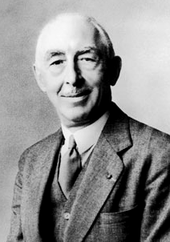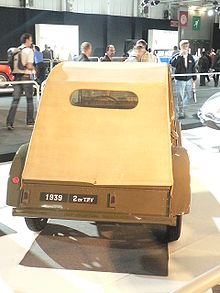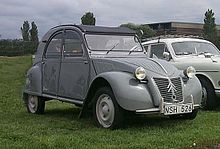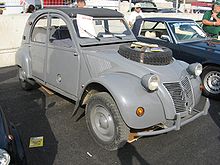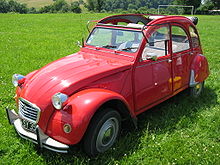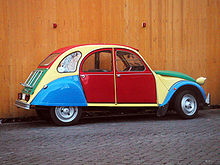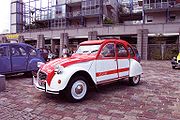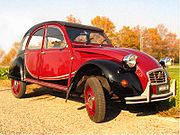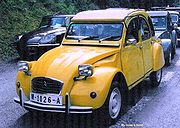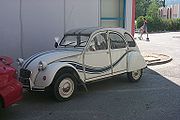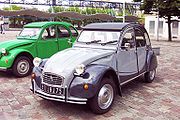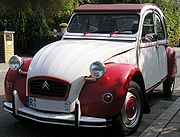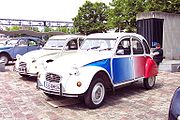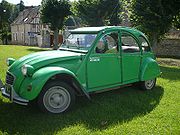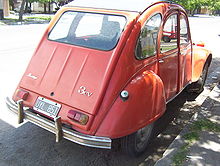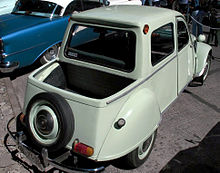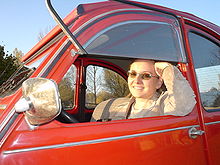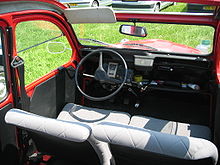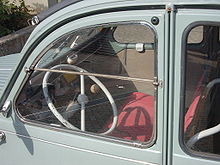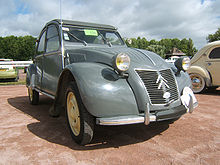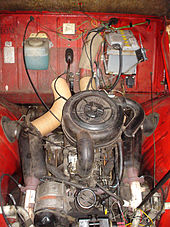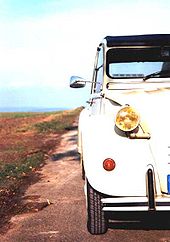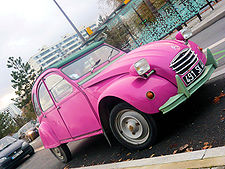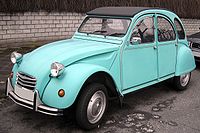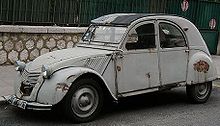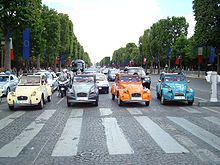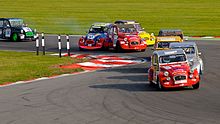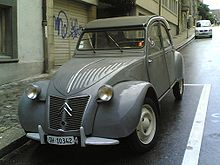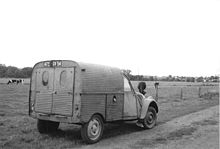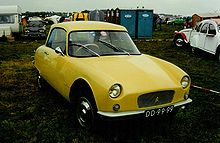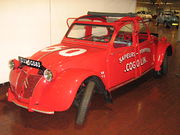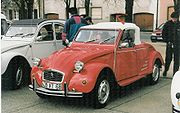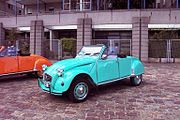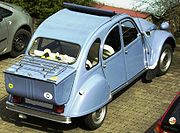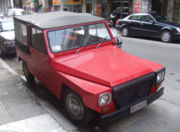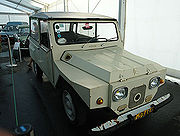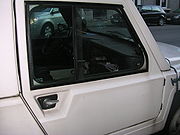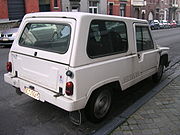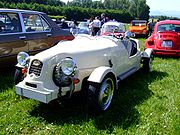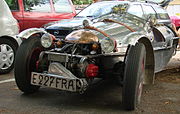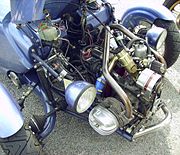- Citroën 2CV
-
Citroën 2CV 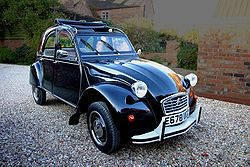
Manufacturer Citroën Production 1948–1990 [1] Assembly Forest/Vorst, Belgium
Liège, Belgium
Slough, UK
Brandsen,
Buenos Aires, Argentina
Montevideo, Uruguay (Panel van & pick-up)
Arica, Chile
Mangualde, Portugal
Paris, France
Vigo, Spain
Koper, SloveniaClass Economy car Body style 2-door panel van
2-door coupé utility (pickup)
4-door landauletLayout Front engine, front-wheel drive / four-wheel drive Engine 375 cc(23CID) H2 air-cooled9hp.
425 cc H2 air-cooled
12hp. 435 cc H2 air-cooled
18hp 602 cc H2 air-cooled 29hp.[2]Transmission 4-speed manual Wheelbase 2.40 metres (94.5 in) Length 3.83 metres (150.8 in) Width 1.48 metres (58.3 in) Height 1.60 metres (63.0 in) Curb weight 560 kg (1,200 lb) Related Citroën Dyane
Citroën FAF
Citroën Méhari
Citroën Ami
Citroën BijouDesigner Flaminio Bertoni The Citroën 2CV (French: “deux chevaux” i.e. “deux chevaux-vapeur [fiscaux]”, literally “two tax horsepower”) was an economy car produced by the French automaker Citroën between 1948 and 1990.[1] It was technologically advanced and innovative, but with uncompromisingly utilitarian unconventional looks, and deceptively simple Bauhaus inspired bodywork,[3] that belied the sheer quality of its underlying engineering. It was designed to move the French peasantry on from horses and carts. It is considered one of Citroën's most iconic cars. In 1953 Autocar in a technical review of the car wrote of "the extraordinary ingenuity of this design, which is undoubtedly the most original since the Model T Ford".[4] It was described by CAR magazine journalist and author LJK Setright as "the most intelligent application of minimalism ever to succeed as a car".[5] It was designed for low cost, simplicity of use, versatility, reliability, and off-road driving. For this it had a light, easily serviceable engine, extremely soft long travel suspension, high ground clearance, and for oversized loads a car-wide canvas sunroof (which until 1955) also covered the boot).
During a production run of 42 years between 1948 and 1990, 3,872,583 2CVs were produced, plus 1,246,306 Fourgonnettes (small 2CV delivery vans), as well as spawning mechanically identical vehicles including the Ami – 1,840,396; the Dyane – 1,444,583; the Acadiane – 253,393; and the Mehari – 144,953, a grand total of 8,756,688.
From 1988 onwards, production took place in Portugal rather than in France. This arrangement lasted for two years until 2CV production halted. Portuguese built cars, especially those from when production was winding down, have a reputation in the UK for being much less well made and more prone to corrosion than those made in France.[6][7][8] Paradoxically the Portuguese plant was more up-to-date than the one in Levallois, and Portuguese 2CV manufacturing was to higher quality standards.[9]
History
The 2CV belongs to a short list of vehicles introduced in the middle of the 20th century that remained relevant and competitive for many decades, such as the Jeep, Land Rover Series, Fiat 500, Mini and Volkswagen Beetle. The 2CV was produced for some 42 years with minimal design changes.
In 1934 family owned Michelin as the largest creditor took over the bankrupt Citroën company. As far back as 1922, when they first conducted market research, they had been interested in expanding the market for economy cars (and tyres) in France, in the same way that the Ford Model T had done in the USA.[10] The new President of Citroën, Pierre Michelin had even gone as far as to build an experimental model at Michelin before the takeover of Citroën.[10] Citroën had stopped producing the economy cars that established the company after the First World War by the mid 1920s, when they moved to using Budd type pressed steel bodies.[10] Michelin believed that decision was a contributor to the later bankruptcy.[10] The new management ordered a fresh and detailed market research survey that was conducted by Jacques Duclos.[10] At that time, France had a very large rural population which could not yet afford automobiles. The results of the survey were used by Citroën to prepare a design brief for a low-priced, rugged "umbrella on four wheels" that would enable four peasants to drive 50 kg (110 lb) of farm goods to market at 50 km/h (31 mph),[11] in clogs and across muddy unpaved roads if necessary. The car would use no more than 3 L of gasoline to travel 100 km (78 mpg). Most famously, it would be able to drive across a ploughed field without breaking the eggs it was carrying.
In 1936, Pierre-Jules Boulanger, the vice-president of Citroën and chief of the Engineering and Design department, set the brief to his design team at the Bureau d'études. The car was to be developed at Michelin facilities at Clermont-Ferrand and at Citroën in Paris in strict secrecy, by the design team who had created the Traction Avant.[10] Boulanger hand picked engineers added to the team,[10] and preferred engineers who had qualified through night school courses, over university trained ones.[10] He believed they were better engineers because of greater practical experience.[10] Boulanger was closely involved with all decisions relating to the TPV, he was obsessed with reducing the weight of the TPV to targets that his engineers thought were impossible. He set up a department that had the job of weighing every component and then redesigning it, to lighten it while still doing its job.[10] He later had the roof raised to allow him to drive while wearing a hat.
Boulanger placed engineer André Lefèbvre in charge of the TPV (Toute Petite Voiture – "Very Small Car") project. Lefèbvre had designed and raced Grand Prix cars, his own speciality was chassis design and he was particularly interested in maintaining contact between tyres and the road surface.[10] In an era of poor damping, beam axles and leaf springs this gave his cars vastly superior grip and handling to most other cars.[10]
The very first prototypes were bare chassis, with rudimentary controls, seating and roof, that needed test drivers to wear leather flying suits, that were used in contemporary open biplanes.[10] By the end of 1937 twenty TPV experimental prototypes had been built and tested.[10]
At the end of 1937 Pierre Michelin was killed in a car crash. Boulanger became President of Citroën and Lefèbvre, responsible for engineering and design, though he wasn't head of the department, he was more like a minister without portfolio; he didn't have an official title.[10]
By 1939 the TPV was deemed ready, after forty-seven technically different and progressively improved experimental prototypes had been built and rigorously tested.[10] Those prototypes made use of aluminium and magnesium parts and had water-cooled flat twin engines with front-wheel drive. The seats were hammocks hung from the roof by wires. The suspension system used front leading arms and rear trailing arms, connected to eight torsion bars mounted beneath the rear seat: a bar for the front axle, one for the rear axle, an intermediate bar for each side, and an overload bar for each side. The front axle was connected to its torsion bars by cable. The overload bar only came into play when the car had three people on board, two in the front and one in the rear, to take account of the extra load of the fourth passenger and fifty kilos of luggage.[3] It was designed by Alphonse Forceau.
During the summer of 1939 a pilot run of 250 cars was produced and on 28 August 1939 the car finally received French market homologation.[12] Brochures were printed and preparations were made to present the car, now branded as the Citroën 2CV rather than as the Citroën TPV, at the forthcoming Paris Motor Show in October 1939.[12] However, in September 1939 the government declared war on Germany, following that country's invasion of Poland. It would be another eight months before the Germans invaded France, but an atmosphere of impending disaster appeared much sooner and with less than a month's notice the 1939 motor show was cancelled,[12] and the launch of the 2CV was abandoned.
During the German occupation of France in World War II Boulanger refused to collaborate personally with German authorities and organized and encouraged sabotage against production for the German war effort to the point where the Gestapo listed him as an important "enemy of the Reich".[10] Boulanger was under constant threat of arrest and deportation to Germany. Michelin, which was Citroën's main shareholder, and Citroën managers decided to hide the TPV project from the Nazis, fearing some military application. Several TPVs were buried at secret locations; one was disguised as a pickup, the others were destroyed, and Boulanger had the next six years to think about further improvements. Until 1994, when three TPVs were discovered in a barn, it was believed that only two prototypes had survived. As of 2003, five TPVs are known. For a long time, it was believed that the project was so well hidden that all the prototypes had been lost at the end of the war. It seems that none of the hidden TPVs were lost after the war, but in the 1950s an internal memo ordered them to be scrapped. The surviving TPVs were, in fact, hidden from the top management by some workers who were sensitive to their historical value.
By 1941, after an increase in aluminium prices of forty percent, an internal report at Citroën showed that producing the TPV post-war, would not be economically viable, given the projected further increasing cost of aluminium[10] Boulanger decided to redesign the car to use mostly steel with flat panels, instead of aluminium.[10] The French motor industry before the war believed that aluminium would become cheaper, and become the standard material for car manufacture.[10] The Nazis had attempted to loot Citroën's press tools; this was frustrated, after Boulanger got the French Resistance to re-label the rail cars containing them in the Paris marshalling yard. They ended up all over Europe, and Citroën was by no means sure they would all be returned after the war.[10] After the liberation, Citroën, along with all the other major French car makers, evaluated and were offered the rights to the air-cooled AFG (Aluminium Français Grégoire) prototype, by Jean-Albert Grégoire, who was unaware of the secret TPV project.[10] It emerged in 1946 as the aluminium Panhard Dyna X.[10] In the Spring of 1944 Boulanger made the decision to abandon the water-cooled two cylinder engine that had been developed for the car and installed in the 1939 versions. Walter Becchia was now mandated to design an air-cooled unit, still of two cylinders, and still of 375cc.[12] At the same time the decision was taken to fit the car with a four speed manual transmission,[12] presumably in response to the performance penalty caused by the extra weight of the steel panels. [13] Other changes included new seats, and a restyling of the body by the Italian Flaminio Bertoni.
It took three years from 1945 for Citroën to rework the TPV into what was its third incarnation,[10] resulting in the car being nicknamed the "Toujours Pas Vue" (Still Not Seen) by the press. The development and production, of what was to become the 2CV was also delayed by the incoming 1944 Socialist French government, after the liberation by the Allies from the Germans. The five year 'Plan Pons' to rationalise car production and husband scarce resources, named after socialist economist Paul-Marie Pons, only allowed Citroën the middle range of the car market, with the Traction Avant. The French government allocated the economy car market, US Marshall Plan aid, US production equipment and supplies of steel, to newly-nationalised Renault to produce their Renault 4CV.[10] The 'Plan Pons' came to an end in 1949.[10] Post war French roads were very different from pre-war ones. Horse drawn vehicles had re-appeared in large numbers.[10] The few internal combustion engined vehicles present, often ran on town gas stored in gasbags on roofs or wood/charcoal gas from gassifiers on trailers.[10] Only one hundred thousand of the two million pre-war cars were still on the road.[10] These were known as 'Les années grises' or 'the grey years' in France.[10]
Citroën finally unveiled the car at the Paris Salon on October 7, 1948.[14] The car on display was nearly identical to the 2CV type A that would be sold the next year, but it lacked an electric starter, the addition of which was decided the day before the opening of the Salon, after female company secretaries had trouble using the pull cord starter.[10] The designers had designed in a starter motor mounting, even though Boulanger had forbidden them from fitting an electric starter.[10] The car was heavily criticised by the motoring press and became the butt of French comedians for a short while.[4] One American motoring journalist quipped, "Does it come with a can opener?"[15] The British Autocar correspondent wrote that the 2CV "is the work of a designer who has kissed the lash of austerity with almost masochistic fervour".[16] Nevertheless, Citroën were flooded with orders at the show, and it had a great impact on the low-income segment of the population in France.
The 2CV was a great commercial success: within months of it going on sale, there was a three-year waiting list, which soon increased to five years. At that time a second-hand 2CV was more expensive than a new one because the buyer did not have to wait.[4] Production was increased from four units per day in 1949 to 400 units per day in 1950. Grudging respect began to emanate from the international press: towards the end of 1951 the opinion appeared in Germany's recently launched Auto Motor und Sport magazine that despite its "ugliness and primitiveness" ("Häßlichkeit und Primitivität"), the 2CV was a "highly interesting" ("hochinteressantes") car.[17]
In 1950 Pierre-Jules Boulanger was killed in a car crash, while on the main road from Clermont-Ferrand (the home of Michelin), and Paris.[10] The same road that Pierre Michelin had been killed on in 1937.[10]
In 1951 production reached over 100 cars a week.[10] Citroën introduced the 2CV Fourgonnette van. It pioneered the use of a large box rear section, as later used by the Morris Minor, Renault 4, Citroën Acadiane and Citroën C15 vans and copied in the 1990s by Vauxhall/Opel and Ford. The "Weekend" version of the van had collapsible, removable rear seating and rear side windows, enabling a tradesman to use it as a family vehicle at the weekend as well as for business in the week. This was the fore-runner of the Citroën Berlingo and Renault Kangoo people carriers introduced in the 1990s. A pick-up truck version was used by the British Royal Navy for pioneering Royal Marine helicopter carrier amphibious operations aboard HMS Bulwark and Albion in the late 1950s and early 1960s, because of the payload limitations of their first large helicopters.[10][18][19] By 1952, production had reached more than 21,000 with export markets earning foreign currency taking precedence, the home was strictly rationed.[10] Boulanger's policy, that continued after his death was; "Priority is given to those who have to travel by car because of their work, and for whom and ordinary cars are too expensive to buy."[10] Dealer sales contracts were provisional and customers needs were verified by the company.[10] The deserving cases were country vets, doctors, midwives, priests and the small farmers that it was originally designed for.[10]
A special version of the 2CV was the Sahara for very difficult off-road driving, built from December 1960-1971. This had an extra engine mounted in the rear compartment and both front- and rear-wheel traction. Only 694 Saharas were built. The target markets for this car were French oil companies, the military, and the police.
From the mid 1950s economy car competition had increased - internationally in the form of the 1957 Fiat 500 and 1955 Fiat 600, and 1959 Austin Mini. On the French home market there was a new small Simca 1000 using licensed Fiat technology, and the new front wheel drive and suspiciously Citroënesque Renault 4, that appeared to have been designed to a very similar, but more modern brief as the 2CV.[10] It marked the beginning of Renault 1960s switch to front engine front wheel drive FF layout, from the rear engine rear wheel drive RR layout. It was the biggest threat to the 2CV eventually outselling it.[10]
In 1960 the 2CV was updated, In particular the corrugated Citroën H Van style "ripple bonnet" of convex swages was replaced (except for the Sahara), with one using six larger concave swages and looked similar until the end of production. Prior to this demand so outstripped supply, Citroën didn't need to spend money on marketing, apart from a few dealer leaflets, at all.[10] A new marketing effort was set up to seriously market the 2CV.[10] Director of publicity Claude Puech came up with humorous and inventive campaigns.[10] Robert Delpire of the Delpire Agency was responsible for the stylish brochures.[10] Ad copy came from Jacques Wolgensinger Director of PR at Citroën.[10] Wolgensinger was responsible for the youth orientated 'Raids', 2CV Cross, rallies, the use of 'Tin-Tin', and the slogan "More than just a car - a way of life".[10] The austerity of the speedometer driven wipers and grey only colour, were replaced by electric wipers and a selection of colours. The fabric roof that had previously been a matter of practical carrying capability, became a 'sun roof'.[10] Marketing materials in the 1960s showed young people and families, having fun and picnics with the removable seats, and even carrying grandfather clocks and bric-a-brac through the open roof.[10] All of this was to try to distance the car from its 1940s post-war austerity associations.[10] The improved 1963-70 AZAM model was the result of all this marketing work. The 1960s were the heyday of the 2CV, when production finally caught up with demand.[20]
In 1967 Citroën launched a new model based on the 2CV chassis, with an updated but still utilitarian body, with a hatchback that boosted practicality: the Citroën Dyane. This was in response to the direct competition by the Renault 4, that had used so many stolen design ideas from the 2CV and Traction Avant that Citroën contemplated legal action at the time of its launch. (Similarly, Volkswagen had had to pay damages to Hans Ledwinka over the Beetle in the 1960s.) At the same time, Citroën developed the Méhari off-roader.
The purchase price of the 2CV was always very low. In Germany in the 1960s, for example, it cost about half as much as a Volkswagen Beetle.
From 1961, the car became offered, at extra cost, with the flat-2 engine size increased to 602 cc (36.7 cu in), although for many years the smaller 425 cc (25.9 cu in) engine [21] continued to be available in France and certain export markets where engine size was critical in determining car tax levels. In 1970 the car gained rear light units from the Citroën Ami 6, and also standardised a third side window in the rear pillar on 2CV6 (602 cc) models. All 2CVs from this date can run on unleaded fuel. 1970s cars featured rectangular headlights.
The highest annual production was in 1974. Sales of the 2CV were reinvigorated by the 1974 oil crisis. The 2CV after this time became more of a youth lifestyle statement than a basic functional form of transport. This renewed popularity was encouraged by the Citroën "Raid" intercontinental endurance rallies of the 1970s where customers could participate by buying a new 2CV, fitted with a ruggedising kit to cope with thousands of miles of very poor or off-road routes. The Paris to Persepolis rally was the most famous.[20] The Citroën "2CV Cross" circuit / off-road races were very popular in Europe.
In 1981 a bright yellow 2CV was driven by James Bond in the film For Your Eyes Only, including an elaborate set piece car chase through a Spanish olive farm, in which Bond uses the unique abilities of the modestly powered 2CV to escape his pursuers in Peugeot 504 sedans. The car in the film was fitted with the flat-4 engine from a Citroën GS for slightly more power.[20] Citroën launched a special edition 2CV "007" to coincide with the 2CV product placement in the film, it was fitted with the standard flat-2 engine, painted in yellow with "007" on the front doors and fake bullet hole stickers. This car was also popular in miniature, from Corgi Toys.
Special edition saloon models
The special edition models, that started with the 1976 SPOT model continued in the 1980s:
- 1980 Charleston — inspired by Art-Deco two colour styles 1920s Citroën model colour schemes
- 1981 007 — in association with the James Bond film For Your Eyes Only
- 1983 Beachcomber — known as 'France 3' in France or 'Transat' in other continental European markets — Citroën sponsored the French Americas Cup yacht entry of that year
- 1985 Dolly - two colours
- 1986 Cocorico — supporting France in the 1986 Football World Cup
- 1987 Bamboo
- 1988 Perrier — in association with the mineral water company
The Charleston became a full model in 1981 and the Dolly in 1985. The Dolly used the "Spécial" models most basic trim rather than the slightly better-appointed "Club" as was the case with the other special editions. In the 1980s there was a range of four full models:
- Spécial
- Dolly (an improved version of the Spécial)
- Club (that was discontinued in the early 1980s)
- Charleston (an improved version of the Club)
All the special editions made a virtue of the individual anachronistic styling. The changes between the special editions and the basic "Spécial" base model, (that was also continued until the end of production), were only a different speedometer, paint, stickers, seat fabric, internal door handles, and interior light. Many of the "special edition" interior trim items were carry-overs from the 1970s "Club" models. Citroën probably gained former VW customers as the only other "retro alternative" economy car style of vehicle[citation needed], the Volkswagen Beetle, was withdrawn from the European market in 1978, (special order only from Mexico in the 1980s), when it ceased production in West Germany.
2CV SPOT2CV Charleston (Rouge Delage / Noir)2CV Charleston (Jaune Helios / Noir)2CV 0072CV BeachcomberCharleston (Gris Cormoran / Nocturne)2CV Dolly2CV Dolly rear2CV Cocorico2CV BambooExport markets
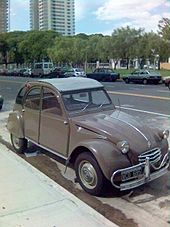 Citroën 2CV with front "Suicide Doors", post-1960 bonnet, and oversized factory protective bumpers in Buenos Aires, Argentina
Citroën 2CV with front "Suicide Doors", post-1960 bonnet, and oversized factory protective bumpers in Buenos Aires, Argentina
The 2CV was mainly sold in France and some European markets. During the post-war years Citroën was very focused on the home market, which had some unusual quirks, like puissance fiscale. The management of Michelin was supportive of Citroën up to a point, and with a suspension designed to use Michelin's new radial tyres the Citroën cars clearly demonstrated their superiority over their competitors' tyres. But they were not prepared to initiate the investment needed for the 2CV (or the Citroën DS for that matter) to truly compete on the global stage. Citroën was always under-capitalised until the 1970s Peugeot takeover. Consequently, the 2CV suffered a similar fate to the Morris Minor and Mini, selling fewer than 10 million units, at 8,830,679[22] of all 2CV based vehicles, whereas the Volkswagen Beetle, which was available worldwide, sold 21 million units.
Some of the early models were built at Citroën's plant in Slough, England from 1953. Until then British Construction and Use Regulations made cars with inboard front brakes such as the 2CV illegal. Producing the car in Britain allowed Citroen to circumvent trade barriers and to sell cars in the British Empire and Commonwealth. It achieved some success in these markets, to the extent that all Slough-built 2CVs were fitted with improved air cleaners and other modifications to suit the rough conditions found in Australia and Africa, where the 2CV's durability and good ride quality over rough roads attracted buyers. The 2CV sold poorly in Great Britain in part due to its excessive cost because of import duties on components. Sales of Slough-produced 2CVs ended in 1960. In 1959, trying to boost sales, Citroën introduced a glass-fibre coupé version called the Bijou that was briefly produced at Slough. Styling of this little car was by Peter Kirwan-Taylor (better known for his work with Colin Chapman of Lotus cars), but it proved to be too heavy for the diminutive 425 cc (25.9 cu in) engine to endow it with adequate performance. It served to use up remaining 2CV parts at Slough in the early 1960s. In 1975, the 2CV was re-introduced to the British market in the wake of the oil crisis. These were produced in France but avoided the crippling import duties of the 1950s, because the UK was by then a member of the EEC. In the 1980s the best foreign markets for the 2CV were the UK and Germany.[20]
Only a few thousand 2CVs were sold in North America when they were new; as in England their pricing was excessive relative to competitors. The original model that produced just 9 hp (6.7 kW) and had a top speed of only 64 km/h (40 mph) (even the fastest of the later models struggled to 115 km/h (71 mph))[23] was unsuited to the expanding post-war US freeway network, and was never widely accepted in North America, unlike the Volkswagen Beetle, which was designed with Autobahns in mind and could reach speeds of over 115 km/h (and later versions were faster still). Citroën was marketed as a luxury brand after the launch of the mid-1950s Citroën DS in North America, and the importers did not actively promote the 2CV, as doing so would undermine the brand image. Unlike larger Citroëns, there are no legal issues with owning a 2CV; the car is effectively a restored pre-1968 vehicle.[citation needed]
A rare Jeep-esque derivative, called the Yagán[19] after an Aborigine tribe, was made in Chile between 1972 and 1973. After the Chilean coup of 1973, there were 200 Yagáns left that were used by the Army to patrol the streets and the Peruvian border, with 106 mm (4.2 in) cannons.
A similar car was sold in some west African countries as the Citroën "Baby-brousse".[24]
In Iran, the Citroën 2CV was called the Jian.[25] The cars were originally manufactured in Iran in a joint venture between Citroën and Iran National up until the 1979 Revolution, when Iran National was nationalised, which continued producing the Jian without the involvement of Citroën.[26]
The 2CV was built in Chile and Argentina for South America. The 1953 Citroneta model of the 2CV made in Chile and Argentina used a type AZ chassis with 425 cc engine developing 12 bhp (8.9 kW). Both chassis and engine were made in France while the 'three box' bodywork (in both 2- and 4-door versions) was designed and produced in Chile. It was the first economy car on the market in Chile. The 1970s Chilean version mounted a 602 cc engine with an output of 33 hp (25 kW), and was designated as the AX-330. It was built between 1970 and 1978, during which it saw changes like different bumpers, a hard roof, front disc brakes, and square headlights.[27] A derivation called the "3CV" was built in Argentina with various modifications such as a hatchback. Citroën had produced more than 200,000 cars in Argentina by 1977; production ended in 1979. A 2CV with a heavily modified front end called the 3CV IES America was produced well into the 1980s, by an Argentinian company that bought the rights and factory from Citroën.[28][29]
The 1981 James Bond movie For Your Eyes Only caused a surge in sales of the car in Chile where it was specially imported from Spain to meet demand (mostly in yellow), since it had already been phased out on the Chilean assembly line.
In 1985, Citroën drew up plans with the Escorts Group to manufacture the 2CV in India for the rural market, as well as spares for export. However, the Indian government rejected this scheme as it would have resulted in competition for Maruti in which they held a stake.
Construction
The level of technology in the 1948 2CV was remarkable for a car of any price in that era, let alone one of the cheapest cars on the planet. While colours and detail specifications were modified in the ensuing 42 years, the biggest mechanical change was the addition of front disc brakes in 1981 (from the discontinued Citroën Dyane), for the 1982 model year.
Features of the 1948 2CV:
- unusual four-wheel independent suspension, front and rear wheels which connected the front and rear suspension on each side
- leading arm front suspension
- trailing arm rear suspension
- rear fender skirts, but the suspension design allowed wheel change without removing the skirts / rear wings
- front-wheel drive
- inboard front brakes, in order to help lower unsprung weight thus making ride even softer
- Four-wheel hydraulic brakes, (British Austin economy cars of the time only had hydraulic front brakes, the rears were by mechanical linkage)
- small, lightweight, air-cooled flat twin engine, (with overhead valves when side valves were still common), mounted very low in front of the front wheels for stability
- 4-speed manual transmission, (when three speeds were common) with an unusual dashboard push/pull/twist linkage
- bolt-on detachable front and rear wings/fenders
- detachable doors, bonnet (and boot lid after 1960), by "slide out" P profile sheet metal hinges
- front rear-hinged "suicide doors"
- flap-up windows, as roll up windows were considered too heavy and expensive.
- detachable full length fabric sunroof and boot lid, for almost pickup-truck-like load carrying versatility
- rack and pinion steering mounted inside the front suspension cross-tube, well behind the front wheels, away from a frontal impact
- load adjustable headlights.
- a heater (heaters were standardised on British economy cars in the 1960s)
The body was constructed of a dual H-frame platform chassis and aircraft-style tube framework, and a very thin steel shell that was bolted to the chassis. Because the original design brief called for a low speed car, little or no attention was paid to aerodynamics. The result was that the body had a drag coefficient (Cd) of a high 0.51.
The Suspension of the 2CV was almost comically soft; a person could easily rock the car side to side dramatically (back and forth was quite a bit more resistant). The leading arm / trailing arm swinging arm, fore-aft linked suspension system together with inboard front brakes had a much smaller unsprung weight than existing coil spring or leaf spring designs. It was designed by Marcel Chinon.[10]
- The system comprises two suspension cylinders mounted horizontally on each side of the platform chassis. Inside the cylinders are two springs, one for each wheel, mounted at each end of the cylinder. The springs are connected to the front leading swinging arm and rear trailing swinging arm, that act like bellcranks by pull rods (tie rods). These are connected to spring seating cups in the middle of the cylinder, each spring being compressed independently, against the ends of the cylinder. Pictured in reference.[30][10][31]
- If each cylinder was rigidly mounted to the chassis, it would provide fully independent suspension, but it is not rigidly mounted. It is mounted using an additional set of springs, originally made from steel, called "volute" springs, but on later models made from rubber. These springs allow the front and rear suspension to interconnect.[10]
- When the front wheel is deflected up over a bump, the front pull rod compresses the front spring inside the cylinder, against the front of the cylinder. This also compresses the front "volute" spring pulling the whole cylinder forwards. That action pushes the rear wheel down on the same side via the rear spring assembly and pull rod. When the rear wheel meets that bump a moment later, it does the same in reverse, keeping the car level front to rear. When both springs are compressed on one side when travelling around a bend, or front and rear wheels hit bumps simultaneously, the equal and opposite forces applied to the front and rear spring assemblies reduce the interconnection significantly, or even completely.[3] This stiffens the suspension after a certain amount of body roll has been achieved. It allows the 2CV to have very soft "bump mode" absorption, without wallow or uncontrolled float.[10]
- It reduces pitching, which is a particular problem of soft car suspension.[3]
- At high angles of body roll, the swinging arms that are mounted with large bearings to "cross tubes" that run side to side across the chassis; combined with the effects of all-independent soft springing and excellent damping, this keeps the road wheels in contact with the road surface and parallel to each other across the axles. A larger than conventional steering castor angle, ensures that the front wheels are closer to vertical than the rears, when cornering hard with a lot of body roll. All this provides excellent road holding, while appearing to look like a softly sprung American car with poor handling and road holding because of poor body control. The other key factor in the quality of its road holding is the very low and forward centre of gravity, provided by the position of the engine and transmission.[10]
- The suspension also automatically accommodates differing payloads in the car- with four people and cargo on board the wheelbase increases by around 4 cm (2 in) as the suspension deflects, and the castor angle of the front wheels increases by as much as 8 degrees thus ensuring that ride quality, handling and road holding is almost unaffected by the additional weight.[10]
- On early cars friction dampers (like a dry version of a multi-plate clutch design) were fitted at the mountings of the front and rear swinging arms to the cross-tubes. Because the rear brakes were outboard, they had extra tuned mass dampers to damp wheel bounce from the extra unsprung mass. Later models had tuned mass dampers at the front (because the leading arm had more inertia and "bump/thump" than the trailing arm), with hydraulic telescopic dampers / shock absorbers front and rear. The uprated hydraulic damping obviated the need for the rear inertia dampers.[10] (It should be noted that only dampers designed to be able to work horizontally should be used as replacements. Some that will physically fit do not work properly horizontally.)
- It was designed to be a comfortable ride by matching the frequencies encountered in human bipedal motion.[10]
This sophisticated suspension design ensured the road wheels followed ground contours underneath them closely, while insulating the vehicle from shocks, enabling the 2CV to be driven over a ploughed field as its design brief required. More importantly it could comfortably and safely drive at reasonable speed, along the ill-maintained and war-damaged post war French Routes Nationales. It was commonly driven 'Pied au Plancher' - 'foot to the floor' by their peasant owners.[3][32]
The 2CV suspension was assessed by Alec Issigonis and Alex Moulton in the mid-1950s (according to an interview by Moulton with CAR magazine in the late 1990s); this inspired them to design the Hydrolastic suspension system for the Mini and Austin 1100, to try to keep the benefits of the 2CV system but with added roll stiffness in a simplified design.
Front-wheel drive made the car easy and safe to drive and Citroën had developed expertise with it due to the pioneering Traction Avant, which was the first mass produced steel monocoque front-wheel-drive car in the world. The 2CV was originally equipped with a sliding splined joint, and twin Hookes type universal joints on its driveshafts; later models used constant velocity joints and a sliding splined joint.
The Gearbox was a 4-speed manual transmission, an advanced feature on an inexpensive car at the time. Boulanger had originally insisted on no more than three gears, because he believed that with four ratios the car would be perceived as complex to drive by customers. Thus, the fourth gear was marketed as an overdrive, this is why on the early cars the "4" was replaced by "S" for surmultipliée. The gear shifter came horizontally out of the dashboard with the handle curved upwards. It had a strange shift pattern: the first was back on the left, the second and third were inline, and the fourth (or the S) could be engaged only by turning the lever to the right from the third. Reverse was opposite first. Although this may seem an odd layout, it is in fact logical. The idea is to put most used gears opposite each other: for parking, first and reverse; for normal driving, second and third. This layout was adopted from the H-van's 3-speed gearbox.
In keeping with the ultra-utilitarian (and rural) design brief, the canvas roof could be rolled completely open. The Type A had one stop light, and like the black Ford Model T was available only in one colour, grey. Glacier Blue was offered in 1959, then yellow in 1960. The windscreen wipers were powered by a purely mechanical system: a cable connected to the transmission; to reduce cost, this cable also powered the speedometer. The wipers' speed was therefore dependent on car speed. When the car was waiting at a crossroad, the wipers were not powered; thus, a handle under the speedometer allowed them to be operated by hand. Although this system was far from perfect, it was better than some 1950s British Ford economy cars that had wipers powered by inlet manifold vacuum, that ran at full speed at engine idle, but slowed down to a crawl when cruising at speed. From 1962, the wipers were powered by a single-speed electric motor. The car came with only a speedometer and a ammeter.[2]
The reliability of the car was increased by the fact that, being air-cooled (with an oil cooler), it had no coolant, radiator, water pump or thermostat. It had no distributor either, just a contact breaker system. Except for the all hydraulic brakes, there were no hydraulic parts on original models as damping was by tuned mass dampers and friction dampers. On later models the mass dampers and friction dampers were replaced by conventional shock absorbers. Early models used a combination of steel pipes and flexible rubber hoses in the braking system. Later 2CV used only steel pipe in the hydraulic braking system; no flexible rubber hoses were used. The front inboard brakes were fixed to the gearbox and did not move with the wheels, while the rear brake pipe was coiled multiple times around the rear trailing-arm mounting tube to absorb suspension movement. This allowed cheaper and lighter assembly, greater reliability and a solid feel at the brake pedal.[citation needed]
Engines
The engine was designed by Walter Becchia and Lucien Gerard,[3] with a nod to the classic "boxer" BMW motorcycle engine (it is reported that Becchia dismantled the engine of the BMW motorcycle of Flaminio Bertoni before designing the 2CV engine). It was an air-cooled, flat-twin, four-stroke, 375 cc engine with pushrod operated overhead valves and a hemispherical combustion chamber. The notoriously underpowered earliest model developed only 9 bhp DIN (6.5 kW). A 425 cc engine was introduced in 1955, followed in 1968 by a 602 cc one giving 28 bhp (21 kW) at 7000 rpm. With the 602 cc engine, the tax classification of the car changed so that it became in fact a 3CV, but the commercial name remained unchanged. A 435 cc engine was introduced at the same time in replacement of the 425 cc; the 435 cc engine car was christened 2CV 4 while the 602 cc took the name 2CV 6 (although a variant did take the name 3CV in Argentina). The 602 cc engine evolved to the M28 33 bhp (25 kW) in 1970; this was the most powerful engine fitted to the 2CV. A new 602 cc giving only 29 bhp (22 kW) at a slower 5750 rpm was introduced in 1979. Despite being less powerful, this engine was more efficient, allowing lower fuel consumption and better top speed, at the price of decreased acceleration. All 2CVs with the M28 engine can run on unleaded petrol, but attention is needed to ensure that valve clearances are maintained.[33]
The 2CV used the wasted spark ignition system for both simplicity and reliability and had only speed-controlled ignition timing, no vacuum advance taking account of engine load.[34]
Unlike other air-cooled cars (such as the Volkswagen Beetle and the Fiat 500) the 2CV's engine had (for simplicity and reliability) no thermostat valve fitted to its oil system to allow the oil to reach normal operating temperature quickly in cold weather. All the oil in the system passed through an oil cooler mounted behind the fan and received the full cooling effect regardless of the ambient temperature. This removes the risk of overheating from a jammed thermostat that can afflict water and air-cooled engines and the engine can withstand many hours of running under heavy load at high engine speeds even in hot weather. To prevent the engine running cool in cold weather (and to improve the output of the cabin heater) all 2CVs were supplied with a grille blinds (canvas on early cars and a clip-on plastic item on later ones) which blocked around half the grille aperture to reduce the flow of cool air to the engine.
The engine's design concentrated on the reduction of moving parts. The cooling fan and dynamo were built integrally with the one-piece crankshaft, removing the need for drive belts. (Late models (shown in photo) used an alternator mounted high above the engine, to keep it dry, run with a drive belt). Instead of using the usual two-piece crank bearings and big ends, one-piece items were hydraulically pressed onto the crankshaft once the crankshaft had been submerged in liquid nitrogen to cause it to contract (thus providing enough clearance to press the bearings on). The entire unit (crank, main bearings and connecting rods was then fitted to the engine. The camshaft drive gears incorporate a spring-loaded split gear, to reduce the effects of gear wear and backlash on valve timing and ignition timing. With the contact breaker in a housing on the end of the crankshaft there was no separate jackshaft to be affected by chain or gear wear and associated backlash.[citation needed]. The use of gaskets, seen as another potential weak point for failure and leaks, was also kept to a minimum. The cylinder heads are mated to the cylinder barrels by a lapped joints with extremely fine tolerances as are the two halves of the crankcase and other surface-to-surface joints.
As well as the close tolerances between parts the engine's lack of gaskets was made possible by a unique Crankcase ventilation system. On any 2-cylinder boxer engine such as the 2CV's, the volume of the crankcase reduces by the cubic capacity of the engine (375 to 602cc in the Citroen's case) when the pistons move together. This, combined with the inevitable small amount of 'leakage' of combustion gases past the pistons leads to a positive pressure in the crankcase which must be removed in the interests of engine efficiency and to prevent oil and gas leaks as the pressure tries to escape. The 2CV's engine has a combined engine 'breather' and oil filler assembly which contains a series of rubber reed valves. These allow positive pressure to escape the crankcase (to the engine air intake to be recirculated) but which close when the pressure in the crankcase drops as the pistons move apart. Because gases are expelled but not admitted this creates a slight vacuum in the crankcase so that any weak joint or failed seal causes air to be sucked in rather than allowing oil to leak out. Since the oil serves both as the engines lubricant and forms a vital part of the cooling system this 'anti leak' system was especially important.
These design features made the 2CV engine highly reliable; test engines were run at full speed for 1000 hours at a time, equivalent to driving 80,000 km (50,000 mi) at full throttle. They also meant that the engine was very much "sealed for life" — the main bearings, for example, could not be replaced individually; the entire crankshaft had to be replaced. However, the engine is very under-stressed and long-lived, so this is not a major issue. Until the 1960s it was common for other car manufacturers' engines to need full strip downs and rebuilds at as little as 80,000 km (50,000 mi) intervals; un-rebuilt 2CV engines are still running that are passing 400,000 km (250,000 mi).[citation needed]
If the starter motor or battery failed, the 2CV had the option of hand-cranking, the jack handle serving as starting handle through dogs on the front of the crankshaft at the centre of the fan. This feature, once universal on cars and still common in 1948 when the 2CV was introduced, was kept until the end of production in 1990. The jack handle also served as the wheelbrace and could be used to remove the nuts that held the front wings on - part of the car's design to facilitate easy maintenance.[citation needed]
Performance
When asked about the 2CVs performance and acceleration, many owners said it went "from 0–60 in one day". Others jokingly said they "had to make an appointment to merge onto an interstate highway system".
The original 1948 model that produced only 9 hp had a top speed of just 64 km/h (40 mph), far below the speeds necessary for North American highways or the German Autobahns already existing then. The top speed increased with engine size to 80 km/h (49 mph) in 1955, 84 km/h (52 mph) in 1962, 100 km/h (63 mph) in 1970, but was not finally capable of US freeway speeds of 115 km/h (71 mph) until 1981.[23]
For all this talk of modest performance data, the trick to driving a flat-twin A-Series Citroen was (and remains) the prudent exploitation of momentum. Any 2CV fitted with a motor of 435cc or more was quite capable of keeping pace with the traffic of the day in most conditions. On occasion this demanded faith in the (remarkable) ability of the car to remain on its wheels while cornering and an ability to resist the urge to brake. At almost any revs in (overdrive) top or third, a corner could be negotiated by changing down, controlling the understeer on the throttle and hanging on.
The last evolution of the 2CV engine was the Citroën Visa flat-2, a 652 cc featuring electronic ignition. Citroën never sold this engine in the 2CV, but some enthusiasts have converted their 2CVs to 652 engines, or even transplanted Citroën GS or GSA flat 4 engines and gearboxes. Cars with the flat-4 engines and subtle bodywork changes so they appear to be standard are known as "Sidewinders" in the UK.
In the mid-1980s CAR magazine editor Steve Cropley ran a turbocharged 602 cc 2CV that was developed by engineer Richard Wilsher.[20][35]
Expeditions
The 2CV has also been used for travel around the world. In 1958–1959, two young Frenchmen, Jean-Claude Baudot and Jacques Séguéla started at the Paris Motor Show on October 9, 1958; headed south and crossed the Mediterranean Sea by boat from Port Vendres to Algeria; traversed the African continent and crossed the South Atlantic from Cape Town to Rio de Janeiro; criss-crossed South America and the United States; and boated from San Francisco to Yokohama. They returned to Paris on November 11, 1959. During the 13 months, they drove 100,000 kilometres, and consumed 5000 litres of petrol and 36 tyres.
Citroën promoted 2CV events called "Raids" in the 1970s, for which main dealers would supply a ruggedising kit. Paris to Persepolis in Iran was the best known.
Nicknames
DIY paintwork was often seen on the 2CV
Popular French nicknames were "Deuche" and "Dedeuche". The Dutch were the first to call it "het lelijke eendje" ("the ugly duckling") or just "Eend" ("duck"), while the Flemish called it "de geit" ("the goat"). In German-speaking countries, it is called "Ente" ("duck"). English nicknames include "Flying Dustbin","Tin Snail", "Dolly", "Tortoise"[36] and "Upside-down pram". In the former Yugoslavia, the car was called "spaček" (pronounced "spa-check", Slovene for "little freak"). In Spanish-speaking countries, they were nicknamed "dos caballos" (two horses), "citrola", "citruca", "cirila", "la rana" (the frog) and derived from "Citroën" were called "citroneta" and "la cabra" (the goat). In Denmark, the car has many names like "Gyngehest" (Rocking horse) or "Studenter-Jaguar" (student's Jaguar) while amongst 2CV enthusiasts the cars are affectionately called "De kære små" (the dear small ones). In Finland, the 2CV is known as "Rättisitikka" (Finnish for "rag Citroën") because of its canvas roof. In Swedish (at least in the Swedish-speaking areas of Finland), it's called "Lingonplockare" (since the looks are similar to a device for picking lingonberries). In Tunisia, they call it "karkassa". In Hungary it is called "Kacsa" (pronounced "kacha" and meaning "duck"). In Israel, it was called "פחנוע" (pronounced "pah-noa", meaning "tin car") and in Iceland it was named "Sítróen braggi" (meaning "Citroën Quonset hut"). In Norway, the name was "Jernseng", meaning "iron bed". In Iran, it is known as "Jian / Zhian ژیان", which means "Fierce".
In the U.S., it was known as the "flying rag top". American cartoonist Gilbert Shelton referred to it as the "duh-shuh-vuh", referring to the French pronunciation of "2CV".
In Ireland it was noticed as the underdog or íochtarán or it was either called bucket of rust or Buicéad na meirge. This was because most imported cars at the time that come to Ireland would have to wait at the pier or harbour for at least for 3–12 months and especially in Westport, County Mayo where it is well known for its constant rain as the 2cv was very prone to corrosion.
Outside France, the 2CV's most common nickname today[citation needed] is "The Duck", which seemed to be endorsed by Citroën which released a stuffed toy animal in the 1980s representing a duck with Citroën on its side and 2CV under its right foot.
End of production
The 2CV was produced for 42 years, the model finally succumbing to customer demands for speed, in which this ancient design had fallen significantly behind modern cars, and safety, where it was better than was generally realised: the front of the chassis was designed to fold up, to form a crumple zone according to a 1984 Citroën brochure. It was rated as comparable for safety, with contemporary 1980s small cars, (that are all very poor by modern standards), by Which? magazine since 1983 when it started rating safety.[37] (The drive for improved crash worthiness in Europe has happened from the 1990s onwards, and accelerated with the 1997 advent of Euro NCAP.) Its advanced underlying engineering was ignored or misunderstood, by the public, being clothed in an ultra basic anachronistic body. It was the butt of many a joke, especially by Jasper Carrott.[38] It was not helped by Citroën failing to promote it after the mid-80s and by falling quality standards. The car was viewed as an embarrassment by Citroën, and they tried to kill the model for several years before the end came.
Citroën had attempted to replace the ultra-utilitarian 2CV several times (with the Dyane, Visa, and the AX); however its comically antiquated appearance became an advantage to the car and it became a niche product which sold because it was different from anything else on sale. Because of its down-to-earth economy car style, it became popular with people who wanted to distance themselves from mainstream consumerism – "hippies" – and also with environmentalists.
Although not a replacement for the 2CV, the AX supermini, a conventional urban runabout, unremarkable apart from its exceptional lightness, seemed to address the car makers' requirements at the entry level in the early 1990s.
In 1988 production ceased in France but was continued in Portugal. The last official 2CV, a Charleston with chassis number 08KA 4813 PT which was reserved for the Mangualde plant manager Claude Hebert, rolled off the Portuguese production line on July 27, 1990. But during the following week, five additional 2CV Special vehicles left the plant;[39] three of their number (one blue, one white with chassis number KA 372168 fitted for a 1991 series that also never materialized,[40] one red) for exhibition at the French "Mondial de l'Automobile" in Paris, October 1990 but this project was later cancelled.
The chassis numerical incrementation was not always sequential. The series number identification badge stock were ordered in bulk and fixed at random on the vehicles when leaving the production line. It often left gaps in the numbering sequence. For instance, on February 29, 1988 a gap of more than 17,500 numbers existed between cars carried on the last truck leaving the Levallois plant. Furthermore the official end of this last French line had been observed on February 19. This confusion began in 1948: the first six 2CVs received in succession the chassis numbers 000 007, 000 002, 000 005, 000 003, 000 348 and 000 006. Thus it is not possible to locate precisely the assembly date of the ultimate chassis numbers displayed: KA 366 694 (Great Britain), KA 359666 (Belgium), KA 375 563 (Germany), KA 376 002 (France) and 08KA 4813 PT (Portugal).[41]
In all a total of 3,867,932 2CV's were produced. Including the commercial versions of the 2CV, Dyane, Méhari, FAF, and Ami variants, the 2CV's underpinnings spawned 8,830,679 vehicles.[22] The 2CV was outlived by contemporaries such as the Mini (out of production in 2000), VW Beetle (2003), Renault 4 (1992), VW Type 2 (still in production as of 2010) and Hindustan Ambassador (originally a 1950s Morris Oxford, still in production as of 2010).
Continued popularity - rebirth?
The design of the 1989 Nissan S-Cargo (a play on the word "Escargot") was directly inspired by the appearance of the tiny French Citroën 2CV Fourgonnette or small truck/delivery van, even including the single spoke steering wheel. The 2CV was relatively popular in Japan at this time. The car was introduced at the Tokyo Motor Show, along with the Nissan Figaro, and was built from 1989 until 1992 by Pike Factory for Nissan. It was based on the K10 Nissan Micra. Approximately 12,000 were manufactured. All S-Cargos are right-hand drive. Although initially marketed only in Japan, S-Cargos have spread as grey market import vehicles.
The Chrysler CCV or Composite Concept Vehicle developed in the mid-1990s is a concept car developed to illustrate new means of construction suitable to developing nations. The car is a tall, fairly roomy four-door sedan, of modest dimensions. The designers at Chrysler note they were inspired to create a modernised Citroën 2CV.
The company Sorevie of Lodève was building 2CVs until 2002. The cars were built from scratch using mostly new parts. But as the 2CV no longer complied with safety regulations, the cars were sold as second-hand cars using chassis and engine numbers from old 2CVs.
The 2CV-Méhari Club Cassis also reconditions the 2CV and the Citroën Méhari. Recently they entered a 2CV prototype in the Paris-Dakar Rally; this was a four-wheel drive, twin-engine car (like the 2CV Sahara) powered by two 602 cc engines, the traditional one in the front and an engine in the rear boot space.[42]
The long-running 2CV circuit racing series organized by The Classic 2CV Racing Club continues to be popular in the UK.
Auto Express reported in a May 2007 news item that a 2CV concept similar in appearance to the 2005 Evoque would make an appearance in 2009, with Citroën likely to position its modern interpretation of the car against premium rivals such as the Mini.[43]
Styling of the Citroën C3 and Pluriel included motifs reminiscent of the 2CV design.
In 2009 Citroën showed in the 2009 Frankfurt Motor Show the Revolte Concept, the design of which was inspired by the 2CV.
Models
Chronology of the development of models during production
Year Developments made to models during production. 1949 The first delivered 2CV (A) 375 cc, 9 hp, 65 km/h (40 mph) top speed, only one tail light and windshield wiper with speed shaft drive (the wiper speed was dependent on the driving speed) 1951 The 2CV receives an ignition lock and a locked driver's door. 1954 The oval frame around the Citroën sign on the grille is removed. The speedometer gets a light for the night driving. 1955 The 2 CV side repeaters are added above and behind the rear doors. It is now also available with 425 cc (AZ), 12.5 hp and a top speed of 80 km/h (50 mph). 1957 A heating / ventilation system is installed. The colour of the steering wheel switches from black to grey. The mirrors and the rear window are enlarged. The bonnet is decorated with a longitudinal strip of aluminum (AZL). In September 1957, the model also AZLP (P for "porte de malle", appears with a boot lid panel. Now you no longer had to open the soft top at the bottom to get to the trunk. 1958 In a Belgian Citroën plant has a higher quality version of the duck (AZL3) produced. It had for the first time a third side window, not available in the normal version, improved details. 1960 The production of the 375 cc engine is ended. In the front fenders round turn signals are integrated. The corrugated metal hood is replaced by a 5-rib glossy cover. Simultaneously, the grille is slightly modified (flatter shape with a curved top edge). Also appears the2 CV 4 × 4Sahara,later calledbimoteur 2 CV. This had been an additional engine-transmission unit in the rear, mounted the other way around and drives the rear wheels. For the second engine, of course, there was a separate push-button starter and choke. With a stick shift between the front seats both transmissions were operated simultaneously. For the two separate engines, there are separate gasoline tanks, under the front seats. Two ignition switches were provided. The filler neck sat in the front doors. Both engines (and hence axles) could be operated independently). The spare wheel was mounted on the hood. The car had, thanks to the all-wheel drive, enormous off-road capability, but at twice the price of the standard 2CV. It was built until 1968 only 693 produced. 1971 one other. Many were used by the Swiss Post as a delivery vehicle. Today they are highly collectible. 1962 The engine power is increased to 14 hp and top speed to 85 km/h (53 mph). In addition, sun roof is installed. 1963 The engine power is increased to 16 hp. The bumper is changed. An electric wiper motor is replacing the drive on the speedo. 1964 The front doors now hinge at the front of the door, instead of at the rear 'suicide doors'. The ammeter is replaced by a charging indicator light. The speedometer is moved from the window frame into the dash. Instead of a dip stick/measuring rod, there is now a fuel gauge. 1965 The grille is changed again: the Citroën logo now sits above the radiator grille. Wavy grille is replaced by three horizontal bars. 1966 The 2CV gets a third side window. As of September 1966 is sold in Germany in Belgium produced a variant with the 602 cc engine and 21 hp Ami6 than 3 CV (AZAM6). This version was only sold until 1968 in some export markets, in France itself, this model was never available. 1967 Between 1967 and 1984 were about 1.4 million Citroën Dyane built. The car is technically based on the 2CV. The exterior is more modern and distinguished by the recessed lights in the fenders and bodywork. The car was designed to appeal to those buyers who were lost after the introduction of the Renault 4. The Dyane was originally planned as an upmarket version of the 2CV and it was supposed to supersede it later. But ultimately, the Dyane was outlived by the 2CV by 7 years - it was simply not accepted by the customers. 1970 The taillights (from the obsolete Ami 6), and front turn signals are changed. From 1970, only two series were produced: The 2CV 4 (AZKB) with 435 cc and the 2CV 6 (Azka) with 602 cc displacement. 1971 The front bench seat is replaced with two individual seats. 1972 Are now fitted as standard with 3-point seat belts. 1973 The 2CV gets new seat covers, a padded Einspeichenlenkrad and ashtrays. 1975 Because of new emission standards power of 28 hp is reduced to 25 hp to reduce emissions. The round headlights are replaced by square, from the interior which are adjustable in height. A new plastic grille is fitted (the Citroën logo now sits back in the middle of the grille). The bumper is changed. 1976 After the Dyane had come onto the market, the sales figures fell rapidly at first. Between 1975 and 1990 under the name of AZKB "2CV Spécial" a drastically reduced trim basic version is sold. It is at first only in yellow, the third rear side windows are gone, the roof can only be opened from the outside, the seats are upholstered in vinyl and it has round headlights only. The small, square speedometer (that dates back to the Traction Avant), and the narrow rear bumper was installed. 1978 The 2CV Spécial there are now red and white colours and in addition it gets a third side window. 1981 Originally planned as a limited edition, which was initially only available in red and black, by popular demand the Charleston becomes a standard model. By changing the carburettor to achieve 29hp and a top speed of 115 km / h. Other changes are, A new rear-view mirror and inboard disc brakes at the front wheels. 1982 All the other 2CV models also get inboard disc brakes at the front wheels. The Charleston gets chromed headlights and a new seat upholstery. In addition, it is available in yellow and black, the colour combination, but a year later replaced by the cormorant grey / night grey . 1986 In Germany and Switzerland a special edition called, "I Fly Bleifrei" - "I Fly Lead Free" is launched, that handles ordinary unleaded, instead of then normal leaded petrol and super unleaded. It was introduced mainly because of stricter emissions standards. In 1987 it will be replaced by the "Sausss-duck" special edition. 1990 The last 2CV leaves the production hall in Mangualde / Portugal on 27 July. A total of 5,114,966 units were built. Standard saloon
Production Data[10]
Model Range Official Code Production Dates Sales Description Engine CC 2CV A 07/49 - 07/59 2CV 375 AZ 10/54 - 10/55 2CV 425 AZ 10/55 - 10/58 2CV 425 AZ 10/58 - 10/61 2CV 425 AZ 10/61 - 04/62 2CV 425 AZ 04/62 - 02/63 2CV 425 AZ (séries A et AM) 03/63 - 12/63 2CV AZL & AZAM 425 AZ (séries A et AM) 12/63 - 02/70 2CV AZL & AZAM 425 AZ (séries A 2) 02/70 - 09/75 2CV 4 435 AZ (série KB) 09/75 - 09/78 2CV 4 435 AZ (série KB) 09/78 - 07/79 2CV Spécial 435 AZ (série KA) 02/70 - 09/75 2CV 6 602 AZ (série KA) 09/75 - 09/78 2CV 6 602 AZ (série KA) 09/78 - 07/79 2CV 6 602 AZ (série KA) 07/79 - 07/81 2CV 6 Spécial, Club 602 AZ (série KA) 07/81 - 07/90 2CV Spécial, Club, Spécial E, Charleston 602 Utility
Production Data[10]
Model Range Official Code Production Dates Sales Description Engine CC 2CV Fourgonnette AU 03/51 - 10/54 2CV - AU 375 AZU 10/54 - 12/55 2CV - AZU 425 AZU 12/55 - 10/58 2CV - AZU 425 AZU 10/58 - 11/61 2CV - AZU 425 AZU 11/61 - 02/62 2CV - AZU 425 AZU 02/62 - 03/63 2CV - AZU 425 AZU (série A) 03/63 - 08/67 2CV - AZU (séries A ) 425 AZU (série A) 08/67 - 08/72 2CV - AZU (séries A ) 425 AZ (série B) 08/72 - 09/75 Citroën 250 435 AZ série AP (AZU) 09/75 - 02/78 Citroën 250 435 3CV Fourgonnette AK 04/63 - 05/68 AK 350 602 AK (série B) 05/68 - 08/70 AK 350 602 AK (série AK) 08/70 - 09/75 Citroën 400 602 AK (série AK) 09/75 - 02/78 Citroën 400 602 AK (série CD) 02/78 - 09/80 Acadiane 602 AK (série CD) 09/80 - 07/87 Acadiane 602 AK (série CD modifie) 09/80 - 07/87 Acadiane G.P.L (L.P.G.) 602 Cabriolet (Radar)
Robert Radar designed a fibreglass body on the chassis of a 2CV in 1956 and built a few prototypes in his Citroën Garage in Liège, Belgium. Citroën Belgium was enthusiastic about this model and decided to produce it as an official Citroën 2CV in its Forest (near Brussels) factory. They manufactured about 50 bodies and added the model called 2CV "Radar" on the price list. They were assembled on order, but in 1958 and 1959, only 25 were sold and production ceased. The remaining bodies were destroyed later. There are five or six of them left, one in the Netherlands and four or five in Belgium.
Coupé (Bijou)
The Bijou was built at the Citroën factory in Slough, UK in the early 1960s. It was a two-door fibreglass-bodied version of the 2CV designed by Peter Kirwan-Taylor. The design was thought to be more acceptable in appearance to British consumers than the standard 2CV. Incorporating some components from the DS (most noticeably the single-spoke steering wheel, and windscreen for the rear window), it did not achieve market success, because it was heavier than the 2CV and still used the 425 cc engine and so was even slower, reaching 100 km/h (62 mph) only under favourable conditions. It was also more expensive than the Austin Mini, which was more practical. Only 207 were built.
Four-wheel drive
Production Data[10]
Model Range Official Code Production Dates Sales Description Engine CC 2CV 4x4 AW 03/58 - 03/63 2CV 4 x 4 "SAHARA" 2 X 425 2CV 4x4 AW/AT 03/63 - 07/66 2CV 4 x 4 "SAHARA" 2 X 425 One novel model was the 2CV Sahara, a four-wheel drive (4x4) car, equipped with two engines (12 hp each), each one having a separate fuel tank.[44] One was mounted in the front driving the front wheels and one in the back driving the rear wheels. A single gearstick, clutch pedal and accelerator were connected to both engines. It was originally intended for use by the French colonies in Northern Africa. As well as a decreased chance of being stranded, it provided four-wheel-drive traction with continuous drive to some wheels while others were slipping because the engine transmissions were uncoupled. Therefore it became popular with off-road enthusiasts. Between 1958 and 1971, Citroën built 694 Saharas, but only 27 are known to exist today. The top speed was 65 km/h (40 mph) on one engine, but this increased to 105 km/h (65 mph) with both engines running.
British journalist Paul Walton flew to Israel to drive one of the 27 examples left, in the desert for the April 2000 issue of Classic Cars magazine.
The Méhari was also built as a 4x4, but with only one engine.
Various 4x4 conversions were built by independent constructors, such as Marc Voisin, near Grenoble, some from a Méhari 4x4 chassis and a 2CV body. In the UK, Louis Barber builds single-engined four-wheel-drive 2CVs. In the late 1990s, Kate Humble from BBC Top Gear tested one against a Landrover Defender off road. The 2cv won.[45]
Although the terminology is sometimes confused, 2CV 4x4 generally refers to these models, whereas 2CV Sahara refers to the two-engined Citroën vehicle.
Another very different double front-ended, four-wheel drive (but not at the same time) 2CV, the 1952 Citroën Cogolin, was built for the French Fire Service - The Sapeur-Pompiers.
Sahara rear engine bayCitroën Méhari (2WD shown, 4WD has bonnet mounted spare wheel)1952 Citroën CogolinCoachbuilt 2CV Cabriolet (using a modified 2CV shell)
Two examples of these are the German Hoffmann[46] and the French Azele.
Hoffmann 2CV CabrioletAzelle CabrioletAzelle Cabriolet RearBoot extensions
Some late model owners fitted "hunchbacks", an extension to the boot. This used the original boot lid, but in a horizontal position with the extension underneath, unlike the 1950s equivalent, which had a curved boot lid reminiscent of a post-war "big boot" Traction Avant.
1950s style boot extension1970s/80s style boot extensionComplete knock down (CKD) locally built cars
The Greek market Citroën Pony[47] and African market Citroën FAF [48] and Baby-Brousse[49] were flat-panelled Mehari type, 2CV based utility cars, built from kits in small low tech assembly plants. There was widespread production of similar 2CV-based vehicles in a large number of countries, including Iran[50] (Baby-Brousse, Jyane-Mehari), Vietnam (Dalat),[51] Chile (Yagan),[19] Belgium (VanClee), Spain, Portugal and others.
Citroën PonyBaby-BrousseBelgian Vanclee MungoVanclee Mungo SideVanclee Mungo RearKit cars and specials
The 2CV's availability, platform chassis construction, low cost and propensity to rust make it an ideal donor car for a special or kit car. Examples of 2CV-based kit sports cars include the Pembleton, BlackJack Avion and the Lomax from Britain, and Burton and Patron from the Netherlands. Most are also available as three wheelers (single wheel at the rear), like an early Morgan sports car. Some have been fitted with larger air-cooled twin-cylinder motorcycle engines. For transportation purposes, some saloon models were rebuilt into vans using glassfibre reconstructions of corrugated 2CV Fourgonnette rear box sections. The 'Bedouin'[52] was a flat panel wooden bodied kit car, that was a spin off from the ill-fated 'Africar'[53] project. It had similarities in looks, to the Citroën Pony and Citroën FAF, CKD locally built cars.
Pembleton front viewPembleton side viewBlackjack Avion Front/SideBlackjack Avion engineBlackjack Avion rearLe PatronReferences
- ^ a b Citroën: Automotive Industry Factsheet
- ^ a b Willson, Quentin (1995). The Ultimate Classic Car Book. DK Publishing, Inc.. ISBN 0-7894-0159-2.
- ^ a b c d e f "The Tin Snail". Channel 4 - Equinox. 1986.
- ^ a b c Compiled by R.M. Clarke. Citroën 2CV Ultimate Portfolio. p. 13. ISBN 1 85520 4266.
- ^ L.J.K. Setright. Drive On!: A Social History of the Motor Car. ISBN 978-1862076983.
- ^ Nick Larkin (July 1997). "Snails of Woe? 2CV Buyers Guide". Practical Classics Magazine.
- ^ Clarke, 2CV Ultimate Portfolio p. 210
- ^ John, Honest (2004-01-31). "Buyers' guide: Citroen 2CV". London: Telegraph. http://www.telegraph.co.uk/motoring/2726714/Buyers-guide-Citroen-2CV.html. Retrieved 2009-08-21.
- ^ 2cv Magazine n° 76
- ^ a b c d e f g h i j k l m n o p q r s t u v w x y z aa ab ac ad ae af ag ah ai aj ak al am an ao ap aq ar as at au av aw ax ay az ba bb bc bd be bf bg bh bi bj John Reynolds. Citroen 2CV. ISBN 978-1844252077.
- ^ René Bellu, Toutes les Citroën, des origines à nos jours, Jean-Pierre Delville éditeur, 1979, p. 250, ISBN 2 85922 014 3
- ^ a b c d e "Automobilia". Toutes les voitures françaises 1940 - 46 (les années sans salon) (Paris: Histoire & collections) Nr. 26: Page 24. 2003.
- ^ At this time French small Peugeot 202|cars]] almost invariably featured three speed transmissions.
- ^ Compiled by R.M. Clarke. Citroën 2CV Ultimate Portfolio. ISBN 1 85520 4266.
- ^ Elsworth, Peter C. T. (June 12, 1998). "The New York Times - AUTOS ON FRIDAY/Collecting; 50 Years of the 2CV's Joie de Vivre". http://www.nytimes.com/1998/06/12/automobiles/autos-on-friday-collecting-50-years-of-the-2cv-s-joie-de-vivre.html. Retrieved 2009-08-20.
- ^ Compiled by R. M. Clarke. Citroën 2CV Ultimate Portfolio P.135. ISBN 1 85520 4266.
- ^ "Not und Spiele: Die 50er Jahre...". Auto Motor u. Sport Heft 13 1996: Seite 58–65. 14 June 1996.
- ^ Philip Chatfield (04/03). 2CVGB Members Handbook P.2-9-1.
- ^ a b c "The 2CV Pick-ups supplied to the Royal Navy". http://www.citroenet.org.uk/foreign/slough/rn-pickup/pick-up.html. Retrieved 2011-02-22.
- ^ a b c d e "The Car's the Star - Citroen 2cv". The Car's the Star. 1996.
- ^ replaced by an updated 435 cc (26.5 cu in) engine in 1968
- ^ a b John Reynolds. Citroen 2CV. ISBN 978-1844252077.
- ^ a b "1966 Citroen 2CV Charleston". Conceptcarz.com. http://www.conceptcarz.com/vehicle/z1453/Citroen-2CV-Charleston.aspx. Retrieved 2011-08-01.
- ^ "Father of 'Black Power' Remembered". Interchange.org. http://www.interchange.org/kwameture/AP112298.html. Retrieved 2009-05-02.
- ^ "Citroën 2CV etc.1". citcity.citroen1.info. http://citcity.citroen1.info/2CV/2cv-etc1.htm#jian. Retrieved 2007-12-01.
- ^ "French Woodies - After 1949". oldwoodies.com. http://www.oldwoodies.com/gallery-french5.htm. Retrieved 2007-12-01.
- ^ "Fabricados en Chile - 2CV Citroneta". http://www.citroenet.org.uk/foreign/latin-america/chile/chile.html. Retrieved 2010-01-07.
- ^ "Argentinian Citroëns". www.citroen.mb.ca. Archived from the original on February 6, 2007. http://web.archive.org/web/20070206164413/http://www.citroen.mb.ca/citroenet/foreign/latin-america/argentina/argentina2.html. Retrieved 2008-05-28.
- ^ "Fabricados en Argentina". http://www.citroenet.org.uk/foreign/latin-america/argentina/argentina1.html. Retrieved 2010-01-07.
- ^ http://www.autospeed.com/cms/gallery/article.html?slideshow=0&a=111302&i=8
- ^ "All about: 2CV suspension". http://www.international2cvfriends.com/forum/viewtopic.php?f=7&t=485&sid=c7c1f98ff729e6aa43fcc6342dbe12cd. Retrieved 2009-10-30.
- ^ "The 2c.v. 375c.c. CITROEN - Unorthodox Suspension". MOTOR magazine. September 17, 1950.
- ^ 2CVGB Members Handbook
- ^ 2CV Stuff "A Series Ignition System". http://www.2cvstuff.com/Files/ignition.pdf 2CV Stuff.
- ^ "2cv club of israel - מועדון הדה שבו". 2cv-il.org. http://www.2cv-il.org/english/Article2cvTurbo.html. Retrieved 2011-08-01.
- ^ Julian Marsh (2000-06-10). "Citroën Publicity GB 2CV Tortoise and From Here To Eternity newspaper ads". Citroenet.org.uk. http://www.citroenet.org.uk/publicity-brochures/gb/2cv/tortoise.html. Retrieved 2011-11-13.
- ^ [1][dead link]
- ^ Compiled by R.M. Clarke. Citroën 2CV Ultimate Portfolio P.208. ISBN 1 85520 4266.
- ^ Citroën-Neuilly Headquarters ref.91MA-JCV/SR, 14.11.1991
- ^ Planete 2cv n° 67 & 69
- ^ L'Alsace, 24.11.98 / Citropolis HS n°3 / LVA, March 1988 and n° 91/36 & 91/38 / 2cv Magazine n° 74 / Jacques Wolgensinger, personal correspondence 01.05.1996 / .
- ^ "Le Dakar 2005". takla-makane.com. http://www.takla-makane.com/pages/dakar/dakar-histo.htm. Retrieved 2007-12-01.[dead link] (French)
- ^ "Citroen's 2CV is back!". autoexpress.co.uk. http://www.autoexpress.co.uk/news/autoexpressnews/208391/citroens_2cv_is_back.html. Retrieved 2007-12-01.
- ^ Motor Sport, February 1963, Page 102.
- ^ BBC Top Gear Land Rover vs 2CV http://www.youtube.com/watch?v=TfcQ-7hIuOQ
- ^ cite web|url=http://www.hoffmann2cv.com
- ^ "Namco Pony Citroën". http://www.citroenet.org.uk/foreign/greece/pony-1.html. Retrieved 2010-01-07.
- ^ "FAF Facile à Fabriquer, Facile à Financer (Easy to build, easy to fund)". http://www.citroenet.org.uk/foreign/faf/faf01.html. Retrieved 2010-01-07.
- ^ "Baby Brousse". http://www.citroenet.org.uk/foreign/baby-brousse/index.html. Retrieved 2010-01-07.
- ^ "Citroën Saipac 2CV, Jiane Sedan, Jiane Pickup and Mehari". http://www.citroenet.org.uk/foreign/iran/jiane/jiane.html. Retrieved 2010-01-07.
- ^ "Dalat the Vietnamese Baby Brousse". http://www.citroenet.org.uk/foreign/vietnam/dalat.html. Retrieved 2010-01-07.
- ^ "2 CV Bedouin". http://www.citroenet.org.uk/foreign/bedouin/bedouin.html. Retrieved 2010-01-07.
- ^ "Africar". http://www.citroenet.org.uk/foreign/africar/africar.html. Retrieved 2010-01-07.
Video references
- The Tin Snail - Equinox Science Series - British Channel 4 Television. 1986. This programme was originally an hour long and features detailed information about the design and engineering of the 2CV, along with interviews with the then surviving design engineers. Part 1, Part 2, Part 3, Part 4, Part 5, Part 6.
- Citroën 2CV Sahara 4x4, Look around the car and a short test drive. Czech with English subtitles.
- 2CV Off-roading Langdale 2007, Part 1, Part 2
- BBC Top Gear Land Rover vs 2CV
External links
- Deux Chevaux Club of Great Britain (2CVGB)
- 2CV Restoring Germany
- The Classic 2CV Racing Club
- 2CVTV, 2CV news and lifestyle website
- 2cv-legende, major French website
- 2CV directory, portal to everything 2CV: websites, articles, stories, contacts and more
- Cats Citroen Net 2CV, history, Buyer's/Owners's Guides, Restoration, Modifying, Codes/Serial Numbers, Reference, Photos
- Greater New York Citroen Velosolex Touring Club
- Citroën A Series Index Page Citroën enthusiasts site.
- garage2cv, Citroën A Series Webzine (Germany)
- Lottie the 2CV
- Musee-2CV, the only museum dedicated to the 2CV (France)
- Studioru, 2CV travel, stories and video
 Media related to Citroën 2CV at Wikimedia Commons
Media related to Citroën 2CV at Wikimedia CommonsType 1950s 1960s 1970s 0 1 2 3 4 5 6 7 8 9 0 1 2 3 4 5 6 7 8 9 0 1 2 3 4 5 6 7 8 9 Economy car 2CV Off-roader Méhari Supermini LN / LNA Dyane Ami Visa Small family car GS Large family car 11 CV ID / DSpécial / DSuper Executive car 15 CV DS CX Grand tourer SM Categories:- Citroën 2CV
- Citroën vehicles
- Front wheel drive vehicles
- Industrial designs
- Subcompact cars
- Sedans
- Vehicles introduced in 1948
- 1940s automobiles
- 1950s automobiles
- 1960s automobiles
- 1970s automobiles
- 1980s automobiles
- 1990s automobiles
- Vehicles with boxer engines
Wikimedia Foundation. 2010.

